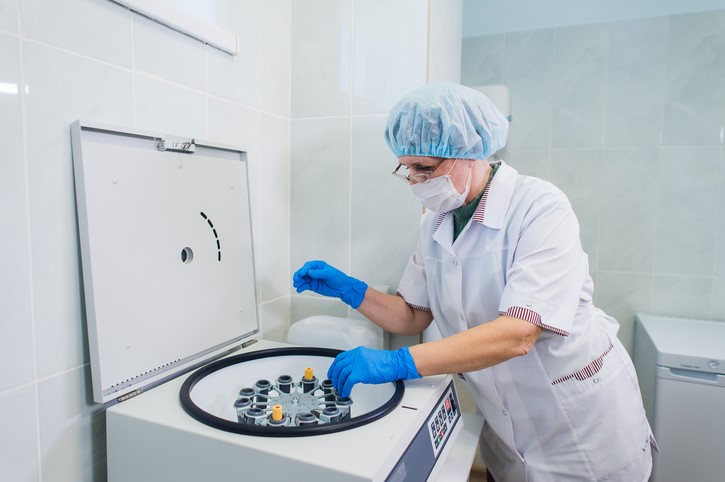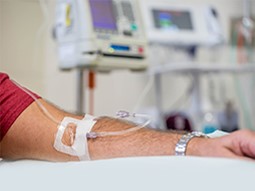What is platelet rich plasma?

Platelet rich plasma (PRP) treatment is a process of using a patient’s own blood products to facilitate healing. A small amount of the patient’s whole blood is drawn into a syringe containing an anti-coagulant. The blood is then centrifuged in a special device to separate the platelet-rich buffy coat, which is suspended in plasma between the red blood cell layer and the platelet-poor plasma fraction. Using these techniques, it is possible to achieve platelet concentrations up to eight times higher than normal, which can then be injected into injured soft tissue.
To more precisely place the therapeutic injectate, a dynamic musculoskeletal ultrasound is often used. Once the exact location is determined, the patient is prepped with a local anesthetic. To better cover the injured area, the PRP injection is most effective when a “peppering” technique is used—injecting the PRP in a clock-like manner. Tendons may also be fenestrated and the PRP seeded into these pockets.
Following the injection, patients may experience worsening pain for several days. It is important to avoid ice and anti-inflammatory medications at this stage, as these interventions may reverse the desired inflammatory response. Pain may be controlled with acetaminophen or other analgesics. There have been no reported adverse reactions to the treatment in the research literature thus far, and it is widely accepted as a safe procedure.
Applications, research, and the future of PRP
For more than 20 years, PRP has been utilized among various specialty groups, including orthopedics, dentistry, otolaryngology, neurosurgery, ophthalmology, urology, wound healing, cosmetic, cardiothoracic, and maxillofacial surgery. Although PRP therapy has been used in these fields for decades, it has recently gained popularity in the United States as a treatment for various musculoskeletal injuries. Recent literature has suggested its efficacy in various surgical and non-surgical applications. PRP has been shown to accelerate bone graft formation in mandibular surgeries, improve fusion rates in spine surgery, and increase efficacy of knee and ankle surgeries. Non-operative PRP studies have shown positive results in the treatment of lateral epicondylitis, infra-patellar tendonitis, and knee osteoarthritis.
Despite convincing evidence of its efficacy, much work remains to be done in exploring the application and utility of PRP. Our regeneration lab and our physicians at MedStar Health continue to explore the efficacy and applications of PRP through active research. This and future studies will provide great insight into this promising treatment, paving the way to a better understanding of common and disabling sports injuries.
PRP reimbursement information
PRP is a relatively new treatment option for patients in the United States; practical uses have been proven effective in Europe for over a decade. Due to its apparent experimental nature, most commercial carriers are not providing reimbursement for this service. It is charged as a fee-for-service offering and must be paid at the time of procedure. Fees for PRP injections range from $1100 to $1300 per injection. Please call for current pricing. We do accept worker's compensation clients for these procedures at the same rate.
Frequently asked questions
-
What is a PRP treatment?
PRP is short for platelet rich plasma. The patient’s own blood is drawn and the healing growth factors and cells are isolated into a rich plasma solution. This can then be injected to various muscles, tendons, and joints to promote healing.
-
Does my insurance cover this procedure?
Unfortunately, not yet. Most insurance companies still consider this to be an experimental therapy, despite growing literature that confirms its effectiveness. Due to the extensive technology and expertise involved, this can be a costly treatment. Most facilities charge between $800 to $2000 for a treatment. Pricing information is available through our scheduling office.
-
Why do you use ultrasound when administering PRP?
Ultrasound images give the physician direct visualization of the internal anatomy. By using this technology, physicians can help determine the exact cause of pain and inject medications with more accuracy.
-
How many injections do I need?
Depending on the exact problem, some patients will require up to three injections. Many patients, however, experience significant improvement after just one treatment.
-
I am told I need a knee replacement. Will this treatment help me avoid surgery?
Possibly. Depending on the extent of disease, PRP may in fact help knees recover from osteoarthritis. Several studies are currently under way to explore this question further.
-
Will this procedure hurt?
We use a local numbing medication to make this procedure as comfortable as possible. Despite this fact, it is not uncommon to experience aching pain for a few days following the procedure.
-
Are there any medications and activities I should avoid after a PRP injection?
Patients should avoid using anti-inflammatory medications such as ibuprofen or naproxen five days before the treatment and for the duration of treatments. These medications will counteract the effects of PRP. Activities may be limited, but this should be discussed on a case-by-case basis.
-
Is PRP the same as prolotherapy?
Prolotherapy works in the same way as PRP in that it promotes inflammation and activates the body’s own healing mechanism. With prolotherapy, sugar water is often injected to stimulate healing.
Our providers

Expert plasma therapy care
Getting the care you need starts with seeing one of our plasma therapy specialists.
Additional information

About Us
MedStar Health draws on extensive resources including its talented staff and state-of-the-art technology, board certified physicians that can address your medical and musculoskeletal problems and provide referrals for therapy services.









